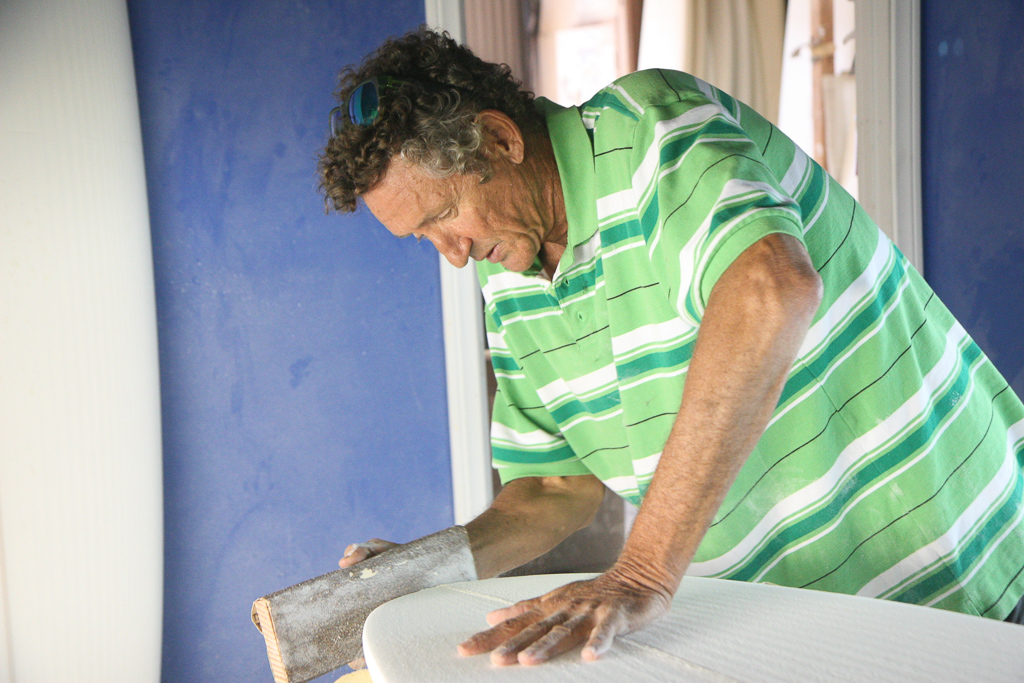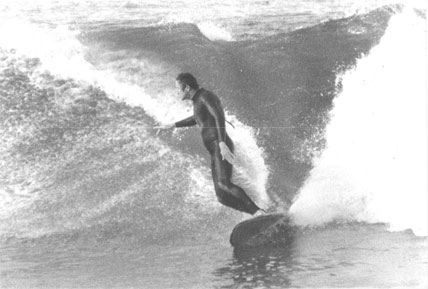Shaper Pat Ryan: Hermosa Beach 2019 Surfer Walk of Fame inductee

Pat “Gumby” Ryan in his Cypress Avenue shaping bay. Photo
Jr.
Pat Ryan began surfing shortly after moving to Hermosa Beach from San Diego.
“I remember riding my Stingray down to The Strand. The Biltmore was there, all boarded up. A little further south was Taco Bell with all the Hells Angels guys,” Ryan said. “Seeing all that was like, whoa.”
“My first board was a 9-foot- Hobie. It had a yellow slipcheck band around the middle that my sister airbrushed on.”

His loose, lanky suring style earned him the nickname Gumby.
“I used to hang out at the Greg Noll store on PCH,” Ryan said. “One day an employee didn’t make it in and I became a salesman.”
Ryan quickly moved into production at Noll’s factory on Cypress Avenue.
“One of the things I used to do, at 15 — I’d make fin panels and while they were jelling try to cut out the whole panel with a linoleum knife before it hardened. Inevitably, it’d go off on me and the big strong guys like Greg Noll would grab the ol’ linoleum knife to finish my job.”
“They finally broke down and bought a band saw.”
Ryan began shaping during the early stages of the shortboard revolution, under the tutelage of Noll and Hawaiian big-wave legend George Downing.
“They knew what they were after,” Ryan said. “George Downing had a specific way of shaping by drawing up the stringer, cutting it out, placing it in a block of foam and shaping the foam to the stringer.
“It was the perfect time to learn how to shape because no one knew what they were doing,” Ryan said.

Pat Ryan displays his versatility. Photo by Mark Kawakami
The two competing schools of board design at the time were the wide-tail, V-bottom developed by Australian Bob Mctavish and Hawiian Dick Brewer’s down-rail boards. Ryan followed Brewer’s lead.
“The down-railers from Hawaii beat down the V-bottom’s from Australia like the Beatles beat down on Dave Clark Five,” Ryan laughed.
During the shortboard revolution of the early ‘70s, many of the established board makers shut down.
“Almost as soon as I started shaping for Greg Noll he went out of business,” Ryan said.
“For surfboard manufacturing, it was the Dark Ages that followed the Golden Age of the ‘60s when Noll, Jacobs, Weber and Bing were selling 100 boards a week.”
In 1972, Eddie Talbot, Noll’s former manager, opened ET Surf on Aviation Boulevard. Ryan joined him and remains his shaper after nearly five decades.
“The ‘70s were a cool time,” Ryan said. It was an era of experimentation. He was shaping fishes, swallowtails, stingers, guns, kneeboards, squaretails, pintails andbonzers. Then came Australian Simon Anderson’s thruster.
“On the first one I made, the trailer fin was actually bigger than the side fins and it had a big, fat, square tail, and was pretty straight.” Ryan said, “I could lift it out of the hole and fly, getting so much distance.”
Channel Islands’ Al Merrick stands out as one of Ryan’s biggest shaping influences.
“It turned out Merrick, a Californian, with pro surfer Tom Curren perfected the thruster,” Ryan said.
Ryan named Phil Becker as another important influence from that era.
“At first I tried to make my boards look like Phil’s. But they never came out like his, so no one could tell I was trying to copy him.”
A longboard renaissance emerged in the early 1990s.
“It brought longboard shapers back to their shaping bays and got surfers who hadn’t surfed in 20 years, back in the water. Bill Stewart deserves a lot of credit for designing the hydro-hull and making longboarding a lot easier,” Ryan said.
During this period, Talbot opened “Just Longboards,” a longboard specialty store next to ET Surf, on Aviation Boulevard in Hermosa Beach. Ryan’s shaping bay was in the back of the store. “JLB” was a throwback to the days when showrooms and shaping rooms were together.
“I had the best time with the shaping room right next to the showroom,” Ryan said. “It was great being the salesman again, like the ‘60s, talking with the customer.”
In the early 2000s, the surf industry was rocked once again, this time by foreign produced, “pop-outs,” made of lightweight, stiff, and overly buoyant epoxy that were almost indestructible. Many big-name shapers sold their brand names to the overseas, epoxy manufacturers. Ryan responded with “The Plastic Trash Revolt,” a manifesto that was circulated throughout the industry.
“I did it, made my point against the pop-out board, got out of it, and let it go,” he said. “I have no time for negatively, but in retrospect you don’t see those things out in the water — that says it all.”
After hand-shaping over 25,000 boards, Ryan felt it was time to advance his shapes with the assistance of a KKL shaping machine. Elbow tendonitis was taking a toll and he appreciated the accuracy of the machine.
“If I had to make one last board, the last board I’d ride forever, would I start out with a piece of foam and a template? No. I’d make my board on the machine.”
“The shaping machine opened up a new era in surf design,” Ryan said, “The machine looks at concaves and subtleties more precisely than a shaper can and lifts surf design to a new, more detailed level.”
After reflecting on shaping longboards for Noll in the ‘60s, then shortboards for ET in the ‘70s, followed by thrusters in the ‘80s, and high performance longboards in the ‘90s, Ryan said board design today is more interesting than ever.
“Surfers are more educated about design,” he said. “Kids get on a PC with an idea for a new shape, and if it works, they give it a name.
“People don’t just ask for a 6-foot square tail. They talk about wider noses, narrower tails, and fin placement,” he explained.
“When people talk to me about the ‘good old days,’ I tell them, ‘The good old days’ are right now.’” ER SWOF
(Reprinted from Drop Zone, December 2012)

